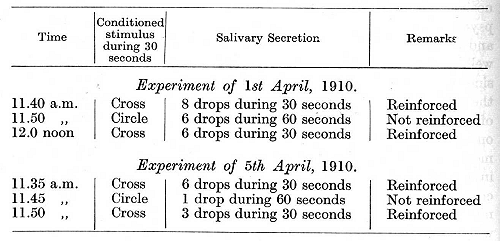
(Return to index)
Posted April 2000
[Classics Editor's note: Pavlov used both square and round brackets in his texts. These have been preserved but can lead to confusions as to which insertions are the author's and which are the editor's. Page numbers, reference numbers, and the occasional "sic" have been inserted in square brackets by the Classics editor. All other insertions (e.g., on p. 31) are by Pavlov. -cdg-]
LECTURE XX
Pathological disturbances of the cortex, result of surgical interference (continued): (c) in the visual analyser; (d) in the tactile cutaneous analyser; (e) occurring after extirpation of the frontal lobes; (f) in the thermal cutaneous analyser; (g) arising after extirpation of the gyrus pyriformis; (h) in the motor analyser.
The pathological disturbances of the visual analyser, which will be discussed next, have not been studied in our laboratory to the same extent as those of the acoustic analyser, but such experiments as have been performed permit us to trace very similar relations in the activity of the two analysers after extirpation of corresponding parts of the cortex.
It was shown by Goltz with his decorticated animal, that the "investigatory reflex" to light can be brought about, in its most rudimentary form of a motor reaction, through sub-cortical areas alone, without any co-operation of the cortex. This, however, is all that could be deduced from Goltz's experiments. Neither is there any indication in the writings of subsequent authors as to the existence in such animals of any higher visual functions. In our decorticated dogs [experiments of Dr. Zeliony], even this elementary reaction was not sharply defined, so that it would seem unquestionable that the entire scope of the visual function beyond this very elementary and limited reaction belongs exclusively to the cerebral cortex, exactly as in the case of the analyser of the mouth (e.g. the water-reflex) and the acoustic analyser in the experiments previously described. It has been shown that even in the case of the primitive analyser of the mouth no conditioned connections could be established in absence of the cortex, although a certain rudimentary analysis was still possible (such dogs rejected many non-alimentary or irritating substances). In the case of the visual analyser there can be no question at all of any possible establishment of conditioned reflexes to visual stimuli exclusively through sub-cortical areas.
In common with all previous observers, including Minkovski, we obtained a very definite diminution of the visual field, either in [p. 342] the horizontal or the vertical direction, in one or both eyes, according to the site of the damage in the occipital lobe on one or upon both sides. Thus, objects which happen to fall within the intact parts of the visual field continue to evoke their corresponding reactions, while the same objects but slightly shifted in position fail to evoke any reaction on the part of the animal. Evidently the occipital lobes must contain the nucleus of the visual analyser, upon the integrity of which depends the existence of visual reflexes, involving the more complicated forms of synthesis and the finer shades of physiological analysis. After bilateral extirpation of the entire occipital lobes none of our dogs ever showed any sign of object vision during the whole time of survival after the operation (one animal survived three years). Neither men nor animals nor food were discriminated by these animals by sight. We would frequently lay upon the floor, or suspend on strings at different heights, pieces of food, but there was not a single dog after bilateral extirpation of the occipital lobes, which, however long it had been deprived of food, ever on one single occasion directed its movement by sight. The dogs directed themselves to the pieces of food obviously only by means of olfactory and tactile stimuli. The definite limitations of the visual field in the horizontal or vertical plane following damage of different regions of the occipital lobes show that the loss of object vision depends upon the absence of the higher synthesis and analysis of visual stimuli rather than upon disturbances in the accessory visual reactions -- convergence and accommodation; moreover, animals with removed occipital lobes equally fail to discriminate objects whether large or small, distant or near, in strong, medium or weak light.
Although the main nucleus of the visual analyser -- the organ of the higher analysis and synthesis of visual stimuli -- is located in the occipital lobes of the cortex, yet these do not constitute the entire analyser. The visual analyser is dispersed over a much wider area, and probably over the whole mass of the cortex. Even in the older days of the physiology of the cortex it was the teaching of several authorities that the frontal lobes also had a definite relation to vision. This conclusion was derived from the impairment of vision which appeared after extirpation of the frontal lobes -- a form of negative evidence which cannot be accepted as sufficient proof, since the facts could be interpreted in terms of a protracted indirect inhibitory after-effect of the operation itself. At the present time, [p. 343] however, we are in a position to offer positive evidence for the view that a part of the analyser capable of performing a considerable visual analysis is situated in the anterior part of the cerebral cortex in front of a line beginning from a point above and immediately behind the gyrus sigmoideus, stretching obliquely downwards and laterally to the anterior angle of the gyrus sylviaticus, and then passing along the fissura fossae sylvii to the lower margin of the hemispheres (see Fig.18, p.363). We found in our dogs, after extirpation of the entire mass of the cortex behind this line, that stable conditioned reflexes could be established to changes in intensity of illumination, observations which are in complete agreement with the experiments of Kalischer. But, in addition to this, we found that a discrimination of tolerably fine gradations of the intensity of illumination could be definitely established. These observations give a simple and purely scientific interpretation of what has been called by H. Munk "psychic blindness." The visual analyser which is considerably damaged after removal of the occipital lobes can now establish conditioned connections only within the scope of a single limited function, namely, reactions to fluctuations in luminosity. On account of this the animal in an illuminated room is still able to avoid dark objects and to walk out through an open door guided by differences in luminosity. In view of these faces it would be more exact to reverse the psychological phrase "that the dog sees but does not understand," and to say "that the dog understands but does not see sufficiently well." Such formularization is, of course, impermissibly redundant, since the whole disturbance primarily consists in the limitation of the analysing activity. The scientific value of this objective point of view has been fully confirmed by our further investigation. In one of our dogs which retained the cortex only in front of the above- mentioned line, it was possible to establish conditioned reflexes involving a still higher function of the visual analyser than discrimination of differences in luminosity. This is the dog which was mentioned as having survived the operation for three years, and which was described at the end of the preceding lecture as having permanently lost the power of analysis of compound auditory stimuli. I shall. describe our experiments upon this animal with the use of visual stimuli in detail [experiments by Dr. Koudrin]. The operation on the hemispheres was performed in two stages, with an interval of one month in between. The final operation took place on the 5th May, 1909. An alimentary conditioned reflex, established [p. 344] before the operation, to switching on a hundred candle-power lamp in a semi-darkened room, definitely returned on the fifth day after the final operation. On the eleventh day it reached an even greater intensity than in the pre-operative period. Experiments with the visual reflex were then abandoned, the work being continued with auditory stimuli as described in the previous lecture. On the 7th September of the same year we began to establish a conditioned reflex to a moving luminous cross projected upon a screen in a semi- darkened room. The reflex developed quickly, and in the course of a week became of a considerable magnitude. >From the 28th September the luminous projection of the cross was held stationary. The reflex was still present although somewhat diminished in intensity. The development of a differentiation of the cross from a circle of equal area and equal luminosity was now begun. At the seventh and subsequent applications of the circle there was already a definite indication of a developing differentiation. The experiments were, however, interrupted and were not taken up again until after an intervening period of six months. After this interval the reflex to the cross was found still to be present. Its differentiation from the circle quickly developed and soon became constant. The following examples reveal a definite, though not yet absolute, differentiation.

A post-mortem examination of the dog three years after the operation confirmed the completeness of the removal of the whole posterior part of the cortex.
There can be no doubt that in this dog the part of the visual analyser that was left in the anterior mass of the cortex was capable not only of establishing conditioned reflexes to changes in intensity [p. 345] of illumination, but also to different shapes of illuminated or shaded areas. At the same time, in this dog, as in all others after removal of the occipital lobes, no conditioned reflexes to separate concrete objects could at any time be established. The development of conditioned reflexes to differently shaped areas was successfully achieved so soon as four months after the operation, and could probably have been obtained even sooner. On the other hand, object vision was entirely absent for the whole post-operative period of the dog's life (3 years), and it is reasonable to suppose that this state of the visual analyser was final and irrevocable, at any rate towards the end of the life of the animal. In this connection it is of interest to inquire how it is that the dog could definitely discriminate areas of different shape during an experiment, and yet could not discriminate objects by their shapes when free. There is, of course, a vast difference between the environing conditions during the experiment and when the animal is set free amid a great number of different objects, each continually changing its aspect either in consequence of its own movement or the movement of the animal in relation to it. The sharpness of contour of the objects similarly never remains constant, depending on changes of illumination and upon the distance from the animal. During the experiment in the stand everything becomes much simpler as compared with the usual environment. Probably, therefore, a very gradual and prolonged practice would have been required for the surviving faculty of discriminating shapes to assume any sort of practical usefulness for the animal.
On the basis of our observations the results of damage of the visual and acoustic analysers may in the main be considered as comparable. A limitation of the visual field signifies a small damage of the visual analyser; in the auditory analyser, if it is permissible to rely on the experiment upon a single dog, a dropping out of auditory compounds of elementary tones has an identical signification. A disappearance of discrimination of objects, i.e. disappearance of compounds made up of forms, shades, colours (in those exceptional dogs in which colour vision may be conjectured), in other words, a disappearance of the higher synthesis and analysis of visual stimuli, signifies a more extensive damage of the visual analyser. A comparable disturbance in the case of the acoustic analyser can be recognized in a disappearance of discrimination of compound stimuli, that is, a loss of higher synthesis and analysis of auditory stimuli. In the case of maximal disturbance of either of the two analysers -- [p. 346] apart from a total destruction -- the only function which survives is the discrimination of intensity of visual or auditory stimuli. Between these extremes there are some intermediate stages, in which, besides differences of intensity, differences in the configuration of luminous areas can be discriminated in the case of the visual analyser, and different types of sound -- noises and musical tones -- in the case of the auditory analyser.
The next question we had to decide was whether the distribution of the tactile analyser over the cortex is analogous to the distribution of the acoustic and visual analysers; in other words, whether besides the special nucleus of the highest activity in this analyser there is a wider dissemination of cortical tactile receptive cells with more limited activities. Although we are not in a position to give a final answer to this question we are yet disposed, on the basis of our experiments, to consider such a distribution as more than probable. I shall give some of our old and also our recent material relative to this question; this material, besides its bearing on the distribution of the analyser, also presents some other points of interest. Many years ago it was observed that a removal of the anterior part of the hemispheres led to a disappearance of tactile conditioned reflexes, while reflexes to stimuli belonging to other analysers were retained [experiments of Dr. Tihomirov]. In later experiments [by Dr. Krasnogorskyl it was definitely established also that the motor area is more or less clearly demarcated from the special nucleus of the tactile analyser, and that definite parts of this special region represent projections of different parts of the skin. One of the dogs had, besides different reflexes belonging to other analysers, a tactile conditioned reflex to acid, which had been experimentally generalized for the whole surface of the skin. The gyri coronarius and ectosylvius anterior were now removed on the left side (see Fig. 14). On the fourth day after the operation conditioned reflexes belonging to the analysers other than the tactile were present. The generalized conditioned tactile reflex returned on the eighth day, but only to stimulation on the left side of the animal, and soon reached its normal magnitude. On the tenth day the tactile reflex returned on the right side of the animal, but only to stimulation of the skin of the middle part of the body. On the fore limb and hind limb, on the shoulder and pelvic area it was entirely absent, the line of demarcation between those areas which had regained, and those which had lost, the reflex to tactile stimulation being very sharp. The loss of these reflexes [p. 347] persisted up to the 90th day following operation, and after this they gradually became re-established, in order, from the shoulder and pelvis to the corresponding paw. These experiments, besides corroborating the localization given by Il. Munk, present another interesting detail. During the period while the conditioned stimuli of the above-mentioned places of the skin had lost their positive effect they divulged a definite inhibitory effect, as has already been mentioned in the lecture dealing with sleep (p. 259). The seemingly ineffective stimulation of these different areas of the skin when used together with, or preceding, the stimulation of other cutaneous areas which continued to give a positive effect, or with, or preceding, conditioned stimuli belonging to other analysers, invariably diminished
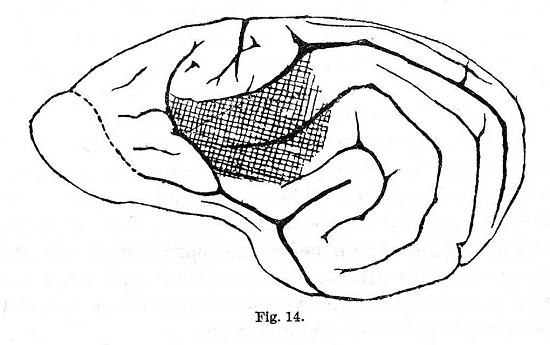
or even abolished such reflexes. Further, a repeated, and even more markedly a protracted, stimulation of these apparently ineffective places on the skin resulted in every experiment in a development of drowsiness and sleep, even in dogs which before the operation never showed any tendency to drowsiness in the stand. The sleep developed in these cases exclusively in connection with the tactile stimulation of these areas; apart from their application the dog kept completely alert during the experiment.
These experiments were quite recently repeated, and with exactly the same results [Dr. Rosenkov]. In a dog in which the same convolutions were partially destroyed all the reflexes belonging to other analysers were present, but only so long as the areas of the skin disturbed by the operation were not stimulated. After stimulation of these areas the animal invariably became sleepy and all conditioned reflexes disappeared throughout the remainder of the experiment. [p. 348]
It was a problem of considerable interest to determine whether it would be possible by some means to disclose anything in the nature of a positive reaction to these tactile stimuli. We succeeded in demonstrating such an effect by the following modification of the experiments. The isolated stimulation of the refractory places of the skin was abbreviated from its usual duration of 30 seconds to 5 seconds. The abbreviated stimulus was now used several times in each experiment, and at the end of the experiment, in order to test the reflex, reinforcement was again delayed for 30 seconds. Under such conditions it was possible to observe the positive as well as the inhibitory effect of the stimulation. The positive effect appeared quickly, but was very small, and, what is important, disappeared while the conditioned stimulus was still acting, whereas the effect of all other conditioned stimuli increased, as usual, towards the end of their isolated action as the moment of reinforcement approached. The following is taken from an experiment by Dr. Rosenkov:
A metronome, a whistle, the light of an electric lamp, and a tactile cutaneous stimulation served as positive conditioned stimuli. After the cerebral operation the conditioned reflex to stimulation of the fore limb disappeared. The secretion of saliva was measured as usual by the graduated tube, five divisions of which correspond to one drop. The secretion before the operation in this dog was generally small. No attacks of convulsions had been observed following the operation. The tactile stimulation in the following table was always applied on the fore limb:
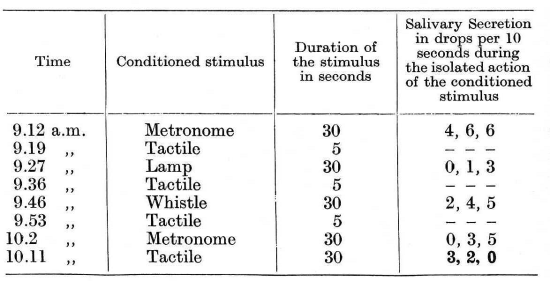
A similar positive effect of stimulation of the usually ineffective places of the skin could be obtained also by some other devices -- with the help of positive induction, by means of dis-inhibition, and [p. 349] by the use of caffeine. This animal obviously presents in respect of the affected cutaneous areas another instance of a maximal faiblesse irritable.
In all our experiments, including those which are being conducted at the present time [Dr. Fedorov], the refractory areas of the skin regain as a general rule, sooner or later after the cerebral operation, their normal positive effect, as has previously been observed by other workers. The question naturally arises as to the mechanism of such recovery. The first explanation to be thought of was a possible existence of direct nerve tracts which had successfully replaced the crossed ones. For the purpose of testing this possibility we now in some dogs extirpated the cortex completely on one side and studied the conditioned tactile reflexes from the skin of the opposite side of the body for the whole time that the animals survived (some of them living for over a year after the operation without attacks of convulsions). Up to the present such experiments have been completed on four dogs. Alimentary conditioned reflexes were employed in most cases; sometimes, however, a defence reflex to acid or to a stimulus of an electric current was also used, the electric stimulus being applied to the skin on that side of the body which was not affected by the cortical lesion [experiments of Drs. Foursikov end Bikov]. The results in all these experiments, in spite of many different modifications, were absolutely negative, and in spite of increasing the cortical excitability by strychnine and caffeine the cutaneous reflexes never returned [experiments of Dr. Foursikov]. Experiments were also conducted to determine whether the tactile stimulation of the injured side of the body would exert any inhibitory influence upon other conditioned reflexes as it did after the partial destruction of the cutaneous analyser [experiments by Dr. Bikov]. In the cases of complete unilateral extirpation of the cortex no such inhibitory influence of the tactile stimuli of the affected side upon the various positive conditioned reflexes (including tactile reflexes from the normal side of the animal) could be observed, whether as an after-effect or during the actual administration of the stimuli; similarly also these tactile stimuli did not induce sleep or drowsiness. These observations are the more important since the same places acquired strong inhibitory properties in those cases where there had been partial destruction of the cutaneous analyser. There was, of course, no question of revealing any positive effect of the stimuli by any of the methods which were successful in the case [p. 350] of partial extirpation. In the case of complete unilateral removal of the cortex, therefore, the tactile stimuli on the opposite side entirely lose their conditioned properties, both positive and negative. In other words, according to our experiments, there is no homolateral connection of the skin with the cortex. Vicariation in the case of partial destruction of the cutaneous analyser must therefore occur with the help of the outlying parts of the analyser in the hemisphere of the same side -- a view which has already been advanced by other authors. In order to study this question of vicariation more closely we resolved to produce an extirpation of as many of the frontal convolutions of one hemisphere as possible, so as to narrow the area from which the compensatory effect might be derived. In dogs operated in this manner the conditioned reflexes to tactile cutaneous stimuli, although they disappeared for a very long time, did nevertheless return. It was thought that the portions adjacent to the operated field might have taken over the function of the removed parts. However, additional destruction of these adjacent parts [experiments of Dr. Eurman] had practically no effect upon the re-established functions of the analyser. The vicariation of function, therefore, must be attributed to much more widely distributed cortical elements. This result made it important to test whether the method which we used for tactile stimulation of the skin was not contaminated by an auditory component so that the reflexes which we observed could be explained by the latter. An apparatus was therefore constructed which, at any rate to our own ear, was entirely without sound, and in order to make the control doubly sure we placed between the apparatus and the skin a medium which prevented the mechanical effect of the apparatus on the skin, without, however, abolishing any possible auditory component inaudible to us. Tactile conditioned reflexes could be developed without, but in no case with, the medium, in either normal or operated animals, proving, of course, that under ordinary conditions the reflexes were genuinely initiated purely by the tactile stimulation and not by any accessory auditory accompaniment.
We are inclined to think that, as in the case of the visual and acoustic analysers, the parts of the cutaneous analyser remaining after the first operation have only a limited function as compared with the function of the cortical elements situated in the extirpated nucleus of the analyser. We hope to test this theory by experiments with compound tactile conditioned stimuli and by using a differentia- [p. 351]tion of the direction of brushing the skin and testing this differentiation upon those places which have recovered from their temporary loss of conditioned reflexes after the extirpation of the frontal lobes. These experiments are in progress at the present time. All the experiments with respect to recovery of tactile reflexes after extirpation are, however, being vigorously repeated in view of their intrinsic importance and in view of the divergence of some results of recent experiments from one of our earlier observations (p. 362).
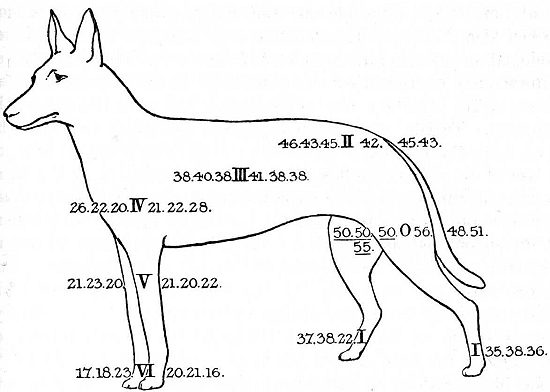
Fig. 15. -- O and Roman figures: -- Numbers of the places stimulated. Arabic figures: -- Conditioned reflex in drops of saliva (1 drop= 0.01 c.c.). The figures to the right and left of the Roman figures were obtained by stimulation of the right and left sides of the animal respectively. the tactile reflex was established on the left side at place O. The fig. shows the spontaneous bilateral formation of accessory reflexes. Note that the strength of the reflexes at corresponding points is identical on both sides of the animal. The reflex which was established at place O was a short-trace reflex.
Besides studying, in the manner described, the relations of the tactile analyser in a single hemisphere, we have also investigated the interrelations of the analysers of the two sides. An observation has already been mentioned that tactile conditioned reflexes which were developed for different places on one side of the body reproduce themselves spontaneously with surprising accuracy on the symmetrical places of the other side of the body. This phenomenon has been especially carefully examined by Dr. Anrep, and its occurrence was demonstrated both for positive and negative reflexes to tactile stimuli (see Fig. 15). It was naturally expected that the development [p. 352] of a differentiation of symmetrical places of the skin on opposite sides of the body would turn out to be a matter of considerable difficulty, and this actually was found to be the case [experiments of Drs. Bikov and Grigorovich].
What is the mechanism of this curious phenomenon? It was only natural to consider first the commissural connections, and in actual fact section of the corpus callosum completely abolished the whole phenomenon. After the section conditioned reflexes to tactile stimulation of the two sides became entirely independent of one another [Dr. Bikov]. The positive and negative tactile reflexes developed on one side now completely failed to reproduce themselves spontaneously on the other side; in order to develop conditioned reflexes on the other side the tactile stimuli had to be independently reinforced. Tactile conditioned stimuli were established with the use of food, the use of the unconditioned defence reflex to acid, or the use of the defence reflex to electrical stimulation of the skin. The electric current in these experiments was of such strength as to produce only a withdrawal of the leg and an investigatory reflex, but no violent defence reaction. The experiments were varied in many different ways, but the result was always the same. The reflexes were confined to the side on which they were developed; reflexes on the other side had always to be developed independently. There was also no longer any difficulty in establishing reflexes of opposite sign for symmetrical places on opposite sides of the body. This is illustrated by the following experiment:
After section of the corpus callosum a tactile stimulation of the right thigh was given excitatory properties and of the left thigh inhibitory properties; and a tactile stimulation of the right shoulder was given inhibitory properties and of the left shoulder excitatory properties. The four reflexes had, of course, to be developed independently.
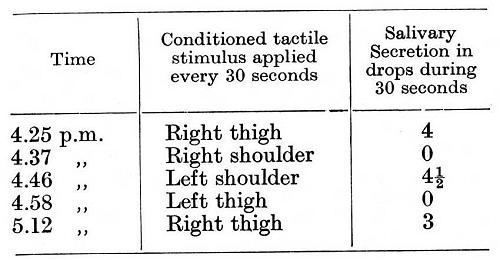
In conformity with the above results all extraneous stimulations of the skin applied on one side of the animal, e.g. a thermal stimulus of 50" C., and a weak electric current, by evoking an investigatory reflex produced an inhibition only of the tactile reflexes on the same side of the body. These experiments were conducted on three animals.
Along with the experiments which were primarily designed for investigation of the tactile analyser, mention must be made of experiments with complete removal of the frontal lobes [experiments of Dr. Babkin]. The frontal lobes were removed upon both sides in front of sulcus praecruciatus and sulcus presylvius down to the lower margin of the hemispheres, involving destruction of the olfactory
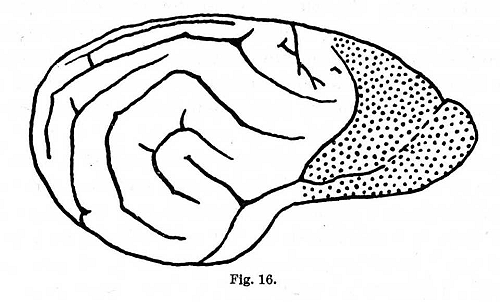
lobes (Fig. 16). Sometimes the knife during the operation, and in almost every case the subsequent pathological process (as shown by post-mortem examinations), involved part of the area behind the line indicated. The experiments were conducted on four dogs. In all cases the old visual and auditory conditioned reflexes returned and new ones could be established soon after the operation. Disturbances --and considerable ones -- were noticed only in the tactile analyser and in the movements of the animal. The dogs lived for 1-6 months after the operation, death occurring in all cases on account of severe attacks of convulsions. During this time no positive tactile reflexes could be re-established for places on the body, but reflexes could be established in some cases for places on the extremities. Good negative reflexes, however, in which the tactile stimulus was used as a conditioned inhibitor, could be produced for any place of the skin. The animals suffered from a persistent cutaneous hyperaesthesia, so that some of them could not bear the loops round [p. 354] their legs during the experiments, and kept quiet only when the loops were discarded. Temporary disturbances in maintenance of posture and locomotion were observed. The animal would often assume an unnatural pose -- drooping head and arched back, paresis of the extremities with twitchings. The motor disturbances were most pronounced in the movement of the mouth, the dog immediately after the operation being able to take food only with difficulty, and having to be fed by hand, especially in the case of solid food. The above were the only peculiarities of note.
In respect of the thermal cutaneous analyser only a small number of experiments have been performed. From these it appears that the thermal, does not entirely coincide with the tactile, analyser in cortical localization. In the case of extirpation of the gyrus praecruciatus [experiments of Dr. Shishlo] tactile conditioned reflexes for the hind limbs were re-established a few days after the operation, while the thermal reflexes (to cold and to a temperature of 47 1/2 C.) conspicuously lagged behind, taking four weeks longer before they returned.
The method of conditioned reflexes was applied also for the verification of the statement made by some authors as to a definite relation of the gyrus pyriformis to the olfactory analyser. The experiments were performed on six dogs which had different "artificial" and "natural" secretory and motor reflexes [experiments of Dr. Zavadsky]. Different unconditioned reflexes were also carefully observed. The first of these reflexes to reappear after complete bilateral removal of the gyri pyriformi and the adjacent part of the hippocampus were the olfactory ones. Movements of the nostrils in response to olfactory stimuli were present so soon as the second or third day after the operation. On the third or fourth day the dogs could select accurately out of many paper bags those that contained meat or breakfast-sausage. On the sixth day the conditioned reflex to the smell of meat powder reappeared, while on the fourteenth day an artificial alimentary conditioned reflex to the odour of camphor became quite definite. The artificial conditioned olfactory reflexes had a positive effect in their first trial, evidence of a spontaneous recovery.
Finally we confronted the question as to the nature of the so-called motor area of the cortex. Is it in all its complexity and delicacy of activities a receptive field and analyser of stimuli initiated within the skeleto-motor apparatus of the organism? In other words, is it comparable to other regions of the cortex which serve as [p. 355] receptive fields and analysers of stimuli falling upon the animal from the outside? Or is it a region physiologically distinct from the remaining parts of the cortex? Is it physiologically comparable to the posterior or to the anterior columns of the spinal cord?
This question is nearly as old as the discovery of the motor area itself, but at the present time there are only a few observers who regard the motor area of the cortex as corresponding functionally to the posterior columns in the spinal cord. In the hope of procuring some fresh evidence we approached the study of this question from the point of view of conditioned reflexes, using some definite motor activity as a conditioned stimulus, and then experimentally determining the localization of this reflex in the cortex. The experiments performed bearing on the motor analyser of the cortex are rather more complicated than other experiments with conditioned reflexes in respect to technique. I have, therefore, no hesitation in giving these experiments in considerable detail, and illustrating my description by a large number of examples [experiments of Dr. Krasnogorski].
Passive flexion of the tibio-tarsal and the metatarso -phalangeal joints were used as conditioned stimuli. The flexion was performed in the following manner. For the passive flexion of the tibio-tarsal joint the thigh and the leg of the hind limb were fixed in a plaster cast attached to a metal frame which was screwed down to the table. In order to employ the metatarso-phalangeal joint the tarsus and metatarsus had also to be rigidly fixed in a special cast. Flexion of the joints was performed in the preliminary experiments by hand and later by a special mechanical device. When the reflex to flexion of the tibio-tarsal joint of the left leg became established the effect was tried of flexion of the same joint of the opposite leg. The reflex was found to be spontaneously present just as in the case of tactile conditioned reflexes. We now started to develop a differentiation of the flexion of the metatarso-phalangeal joint (toes) of the left leg from flexion of its tibio-tarsal joint (ankle). The differentiation became established after 42 reinforcements of the flexion of the toes contrasted with 74 flexions of the ankle. This differentiation spontaneously reproduced itself for the respective joints of the right side also. Since flexion of any joint invariably involves a mechanical stimulation of the skin, which by itself might have been responsible both for the conditioned reflexes and the differentiation, further experiments had to be performed in order to dissociate the cutaneous component from the actual flexion itself. For this purpose all sorts [p. 356] of mechanical stimulations of the skin were applied, touching, pressing, gripping, and rhythmic stretching of the skin on one side of the joint and folding on the opposite side in imitation of the natural stretching and folding in the case of flexion of the joint. The latter kind of stimulation produced the strongest effect. On repetition of these cutaneous stimuli, of course without any reinforcement, they finally became entirely ineffective while flexion itself, which was always reinforced, continued to act. It was realized, however, that all these precautions did not afford absolutely definite proof that flexion by itself acted in these experiments as the sole conditioned stimulus. It seemed quite possible that al our variations of mechanical stimulation of the skin did not entirely reproduce those accompanying flexion of the joint. It was essential to find a more conclusive proof that flexion itself became a conditioned stimulus. We expected to find such proof by completely excluding the cutaneous component by extirpating those cortical parts of the tactile analyser which were known to stand in relation to tactile stimuli from the areas involved, namely, the gyri coronarius and ectosylvius (see Fig. 14, p. 347). Previously to the operation additional alimentary conditioned reflexes were established to tactile stimulation of the hind limbs at five distinct places and to a tone of 500 vibrations. The operation was performed on the left side of the cortex. The tone was the first conditioned reflex to reappear, and this occurred on the seventh day. The first trial of the flexion on the damaged (right) side -- on the eighth day after the operation -- gave a negative result. The second trial -- performed on the same day -- gave a secretion of 2 drops during 30 seconds. The trial on the tenth day gave a secretion of 3 drops: on this day a simultaneous stimulation of the five tactile places on the same extremity remained entirely without effect. On the twelfth day the reflex to flexion reached 5 drops, while the stimulation of the five tactile places and folding and stretching of the skin still remained without effect. On the thirteenth day the folding and stretching of the skin over the joint exerted an inhibitory influence upon the effect of the tone applied simultaneously. Again, when on the fifteenth and sixteenth days the left (undamaged) hind extremity recovered from the inhibitory effect of the operation and the tactile stimulation of this limb gave already a considerable secretory effect, the same tactile stimulation applied simultaneously with folding and stretching of the skin over the right joint became ineffective. Thus, the folding and stretching of the skin over the [p. 357] right joint had now become, as an after-effect of the operation, inhibitory instead of excitatory. Nevertheless, flexion of the joint continued invariably to produce a salivary secretion. The following are the results of some of the individual experiments:
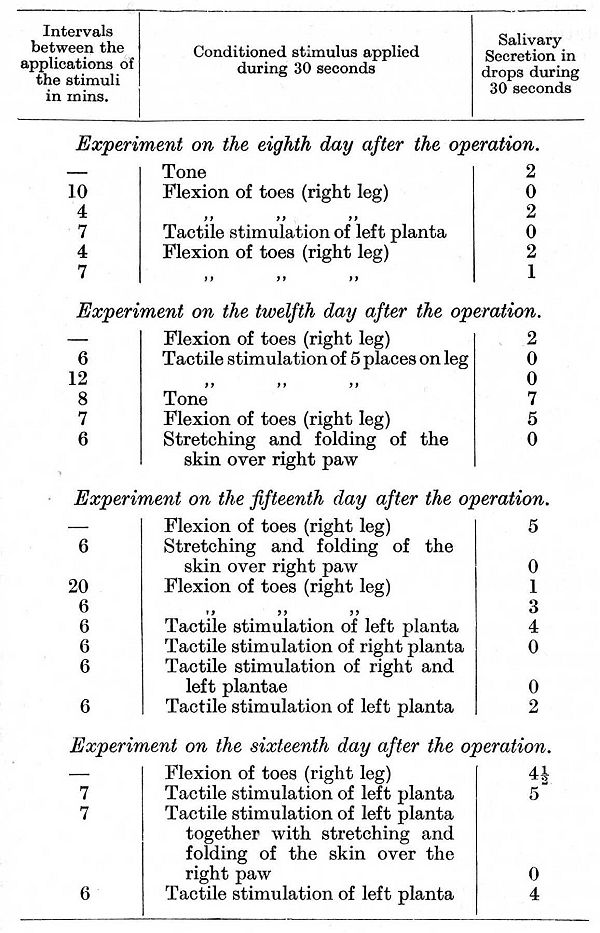
The above experiments justify the two following conclusions. First, that a passive flexion of the joint by itself, i.e. independently of the involved cutaneous component, can serve as a conditioned stimulus. Second, that the stimuli arising from such movement and the associated cutaneous stimuli have different areas of representation in the cortex. The problem remains therefore to determine the localization of the cortical area of muscular proprioception. The problem was solved by the following experiment performed on a dog in which the gyrus sigmoideus dexter had been completely
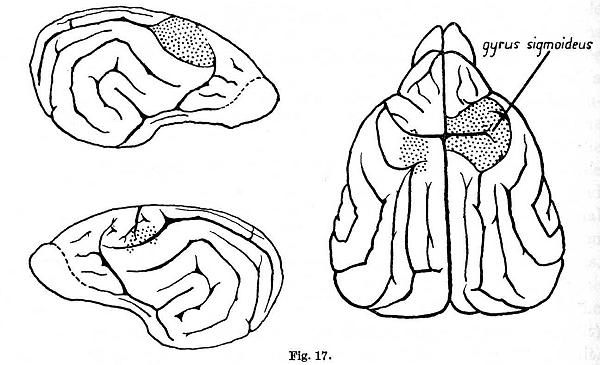
removed two months previously, since when obvious motor disorders had prevailed in both extremities of the left side. During the operation the gyrus sigmoideus sinister had also been very slightly damaged, but not sufficiently to produce any disturbing influence on the extremities of the right side. The tactile conditioned reflexes in this animal were normal over the whole surface of the skin. We began with the establishment of a conditioned reflex to flexion of the right (i.e. homolateral) metatarso-phalangeal joint. This reflex developed very quickly. We now began the differentiation of the flexion from its cutaneous component, using all the above-mentioned variations of mechanical stimulation of the skin and the joint, and never, of course, reinforcing the cutaneous stimuli. Within a month the differentiation was fairly well established (although it was not always absolute), showing that the right side was normal. The following is an example taken at random: [p. 359]
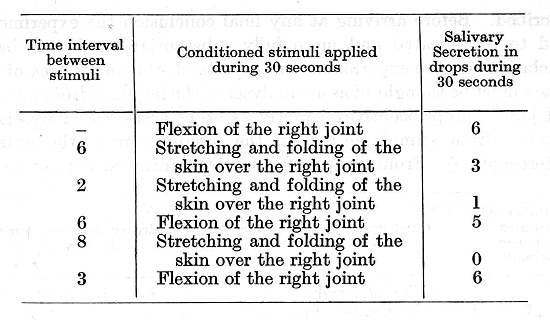
We began now to test the reflexes on the left (i.e. heterolateral) side of the body. Stretching and folding the skin over the left hind paw was entirely ineffective right from the very start, in accordance with the symmetrical spontaneity of development of reflexes discussed before. In contrast with the right side, however, the reflex to the flexion itself was also absent. When the flexion on the left side was now reinforced, the corresponding mechanical tactile stimulation, when tested separately, was found also to have acquired secretory properties. On continuing these experiments, in spite of most persistent attempts, at development of differentiation, it was found impossible to develop a conditioned reflex to flexion separately from the tactile cutaneous component. As soon as the effect of mechanical stimulation of the skin was extinguished the reflex to flexion invariably disappeared also. On reinforcing the flexion the cutaneous reflex also invariably returned. The result of these experiments must be interpreted as follows: pure flexion on the left side was by itself ineffective, but the reinforcement of the flexion of the joint produced a positive effect through the agency of the tactile component unavoidably accompanying flexion. In contrast with this, the differentiation between the flexion and the tactile stimulation on the right leg was constant and quite definite. The table shown on page 360 is an example.
The experiments show that the gyrus sigmoideus is the area of cortical representation of stimuli initiated in the skeleto-motor apparatus during the passive flexion.
Unfortunately we have not pursued this study further and have not employed any variations of the experiments other than those [p. 360] described. Before arriving at any final conclusion the experiments need to be repeated and more fully substantiated. If one bases conclusions on the experiments as they stand, the motor area of the cortex must be thought of as an analyser of the impulses from muscles and joints (proprioceptive), exactly as other areas are analysers of impulses from stimuli acting on the organism from the outside (exteroceptive). From this point of view the entire cortex represents
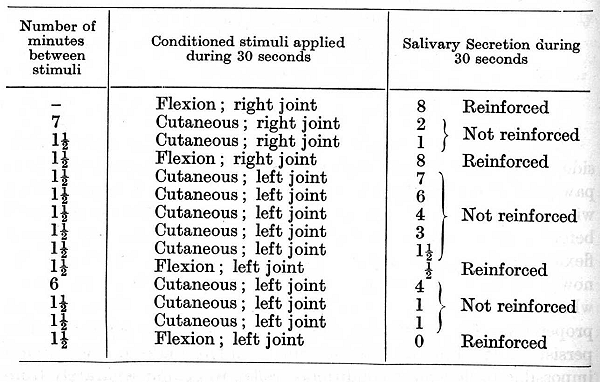
a complex system of analysers of the internal as well as of the external environment of the organism. Obviously, if one accepts this hypothesis in relation to the motor activity, there is good reason to extend it to the activity of most, if not all, other tissues of the organism. The important role played by auto-suggestion with all its extraordinary aspects, as, for example, imaginary pregnancy, and all sorts of imaginary diseases, can be understood from the physiological point of view only if we admit the existence of corresponding cortical analysers, even though they may be only little differentiated and indefinite.